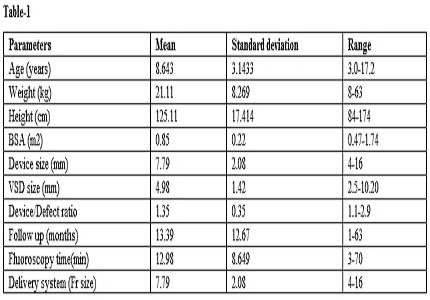Cardiac rhythm abnormalities after transcatheter device closure of perimembraneous ventricular septal defects in pediatric patients at intermediate term follow up
Abstract
Background: Transcatheter closure of perimembranous ventricular septal defects in pediatric patients poses special challenges owing to anatomical relationship between conduction system and perimembraneous ventricular septal defect.
Aims: The study aims to assess and evaluate the conduction disturbances after transcatheter device closure of perimembranous ventricular septal defect using different occluders at mid-term follow-up.
Methods: We studied 297 patients having PMVSD with clinical and/or echocardiographic evidence of a significant left-to-right shunt. All subjects underwent clinical examination, electrocardiogram (ECG), chest X-rays and transthoracic echocardiography before discharge and at 1, 6 and 12-months after the procedure and yearly thereafter. Platelet anti-aggregation therapy with aspirin 5 mg/kg/day orally and endocarditis prophylaxis was prescribed for six months.
Results: The mean age of the patients was 8.64±3.14 years (range 3-17.2 years). Majority (86.2%) had no residual shunt at follow-up. Total rhythm disturbances were seen in about 6% (18/297) of patients with transient complete atrioventricular block (CAVB) occurring in 3 patients. There was no mortality in our study which compares well with the surgical results in which it is between 0-3 percent.
Conclusions: This study showed that transcatheter closure of PMVSD using symmetric PMVSD occluders and duct occluders is a safe and effective alternative to surgery. Oversizing of devices should be minimized and low profile devices appropriate to specific morphology of VSD should be used. It has excellent results in experienced hands with minimum morbidity and almost no mortality.
Downloads
References
2. Fyler DC, Buckley LP, Hellenbrand WE, Cohen HE. Report of the New England Regional Infant Cardiac Program. Paediatrics. 1980; 65(Suppl):376–461.
3. Newman TB. Etiology of ventricular septal defects: an epidemiologic approach. Pediatrics. 1985 Nov;76(5):741-9. [PubMed]
4. Kidd L., Driscoll D.J., Gersony W.M.; Second natural history study of congenital heart defects. Results of treatment of patients with ventricular septal defects. Circulation. 87 1993:I38-I51.
5. Bol-Raap G., Weerheim J., Kappetein A.P., Witsenburg M., Bogers A.J.; Follow-up after surgical closure of congenital ventricular septal defect. Eur J Cardiothorac Surg. 2003;24:511-515. [PubMed]
6. Wollenek G, Wyse R, Sullivan I, Elliot M, de Leval M, Stark J. Closure of muscular ventricular septal defects through a left ventriculotomy. Eur J Cardiothorac Surg. 1996; 10:595–598. [PubMed]
7. Backer CL, Winters RC, Zales VR, Takami H, Muster AJ, Benson DW, Mavroudis C. The restrictive muscular ventricular septal defect: how small is too small to close? Ann Thorac Surg. 1993;56:1014.
8. Carminati M, Butera G, Chessa M, Drago M, Negra D, Piazza L. Transcatheter closure of congenital ventricular septal defect with Amplatzer septal occluders. Am J Cardiol. 2005; 96 (12): 52-58. [PubMed]
9. Abe T, Komatsu S. Conduction disturbances and operative results after closure of ventricular septal defects by three different surgical approaches. Jpn Circ J. 1983;47:328–35. [PubMed]
10. Serraf A, Lacour-Gayet F, Bruniaux J, Ouaknine R, Losay J, Petit J, Binet JP, Planche C. Surgical management of isolated multiple ventricular septal defects: logical approach in 130 cases. J Thorac Cardiovasc Surg. 1992;103:347–342.
11. Gu MB, Bai Y, Zhao XX, et al. Transcatheter closure of postoperative residual perimembranous ventricular septal defects. Ann Thorac Surg. 2009;88:1551–1555.
12. William YC, Zimmerman F, Hijazi ZM. Heart block and empirical therapy after transcatheter closure of perimembranous ventricular septal defect. Catheter Cardiovasc Interv. 2005; 66: 436–441.
13. Fu Y-C, Bass J, Amin Z, et al. Transcatheter closure of perimembranous Ventricular septal defects using the new Amplatzer membranous VSD occluder: Results of the U.S. phase I trial. J Am Coll Cardiol. 2006; 47:319–25.
14. Butera G, Chessa M, Carminati M. Late complete atriovenous block after percutaneous closure of a perimembranous ventricular septal defect. Catheter Cardiovasc Interv. 2006;67:938–41.
15. Pinto RJ, Dalvi BV, Sharma S. Transcatheter closure of perimembranous ventricular septal defects using the Amplatzer asymmetric ventricular septal defect occluder: preliminary experience with 18-month follow-up. Catheter Cardiovasc Interv. 2006;68:145-52.
16. Arora R, Trehan V, Kumar A, Kalra GS, Nigam M. Transcatheter closure of congenital ventricular septal defects. Experience with various devices. J Interv Cardiol. 2003;16:83-91.
17. Selzer A. Defect of the ventricular septum. Arch Int Med. 1949;84:798–823. [PubMed]
18. Becu LM, Fontana RS, Dushane JW, Kirklin JW, Burchell HB, Edwards JE. Anatomic and pathologic studies in ventricular septal defect. Circulation. 1956; 14: 349–64. [PubMed]
19. Soto B, Becker AE, Moulaert AJ, Lie JT, Anderson RH. Classification of ventricular septal defects. Br Heart J 1980; 43: 332–43. [PubMed]
20. Capelli H, Andrade JL, Somerville J. Classification of the site of ventricular septal defect by 2-dimensional echocardiography. Am J Cardiol. 1983; 51:1474–80. [PubMed]
21. Butera G, Carminati M, Chessa M, Piazza L, Micheletti A, Negura DG, Abella R, Giamberti A, Frigiola A. Transcatheter closure of perimembranous ventricular septal defects: early and Long-term results. J Am Coll Cardiol. 2007; 50:1189–1195.

Copyright (c) 2016 Author (s). Published by Siddharth Health Research and Social Welfare Society

This work is licensed under a Creative Commons Attribution 4.0 International License.


 OAI - Open Archives Initiative
OAI - Open Archives Initiative


